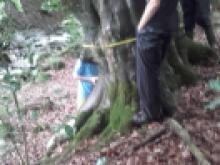Since I’ve taken on the Churnet Valley Veteran tree project the one question that I have been asked by far the most, from both colleagues and the public is this:
“What is a veteran tree?”
The definition of a veteran tree depends on what document you are reading, which expert you are talking to and – it seems to me – what day of the week it is! In essence the idea of a veteran tree can be attributed to anything from size and age to historical and cultural importance. Although this can be confusing I think it is a sign of an underlying positivity towards trees – no matter who you are or what your expertise a tree can be important to you in one of many ways.
As somebody who has an ecological background I see a veteran tree as one with dead wood features that provide homes and food for rare plants and animals. As trees go through life they get attacked from every direction. The wind tries to blow them down, animals try to eat their leaves and bark, fungi try to digest them from inside and insects bore holes into them to make their homes. All these attacks leave scars that can last for hundreds of years and as the tree gradually accumulates these injuries it provides homes and food for a bigger and better diversity of other animals and plants.
Holes that open up when the wind snaps branches provide homes for birds and an entry point for fungi and insects. As animals damage the bark they leave holes for other to enter and as fungi starts to rot the inside of the tree they provide food for insects, which provide food for birds and mammals. Trees that become hollow develop their own little ecosystem inside complete with plants and animals, predators and prey.
As somebody who is interested in the natural world on a more primal level I also see a veteran tree as one with importance to people. It may have a ghost story or other kind old legend attached to it. It may be a tree that was planted by a long lost relative or it may simply be a tree that a person climbed as a child or that somebody’s child stills climbs and plays around today. Whatever the connection I think a tree’s capacity to inspire people is invaluable.
This project aims to both protect and enhance the ecological features around veteran trees but also document local people’s connection to their trees.
This is the first in a series of blogs about veteran trees and their value that I will be posting over the next couple of months. In next week’s blog I’m going to explore...
I’m also going to include a tree based trivia fact for the week as well, so here’s the first one:
The Anglo Saxon word for tree was “beam” and not only is this why we get the word beam for a joist or lintel that’s made of wood but also where we get the names for Whitebeam and Hornbeam trees. In fact an old name for rowan trees is Quickbeam referring to them being so short lived.



